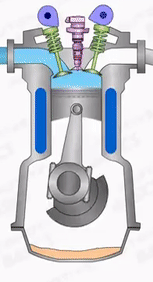The Inlet Valve opens (IVO) 10* to 25* before the TDC. Fresh air is sucked into the engine cylinder till the inlet closes.
The Inlet Valve closes (IVC) 25* to 50* after the BDC. The air is compressed till the fuel is injected.
The fuel Injection starts ( FIS ) 5* to 10* before TDC in the compression stroke. The air - fuel mixture burns. Both the temperature and pressure increase. The Burning gases are expanded till the exhaust valve opens.
The Exhaust Valve opens (EVO) 30* to 50* Before the BDC. The Exhaust gases are forced out of the cylinder till the exhaust valve closes.
The Exhaust Valve Close (EVC) 10* to 15* after the TDC. Before closing the exhaust valve, again the inlet valve opens 10* to 25* before the TDC. The period when both the inlet and exhaust valves are opened is known as valve overlap period. The angle between these two events is known as angle of valve overlap.


Comments
Post a Comment